Locality Sensitive Hashing
Contents
Locality Sensitive Hashing#
1. Applications of set-similarity#
Many data mining problems can be expressed as finding similar sets:
Pages with similar words, e.g., for classification by topic.
NetFlix users with similar tastes in movies, for recommendation systems.
Dual: movies with similar sets of fans.
Entity resolution.
2. Application: similar documents#
Given a body of documents, e.g., the Web, find pairs of documents with a lot of text in common, such as:
Mirror sites, or approximate mirrors.
Application: Don’t want to show both in a search.
Plagiarism, including large quotations.
Similar news articles at many news sites.
Application: Cluster articles by
same story: topic modeling, trend identification.
3. Three essential techniques for similar documents#
Shingling : convert documents, emails, etc., to sets.
Minhashing : convert large sets to short signatures, while preserving similarity.
Locality sensitive hashing : focus on pairs of signatures likely to be similar.
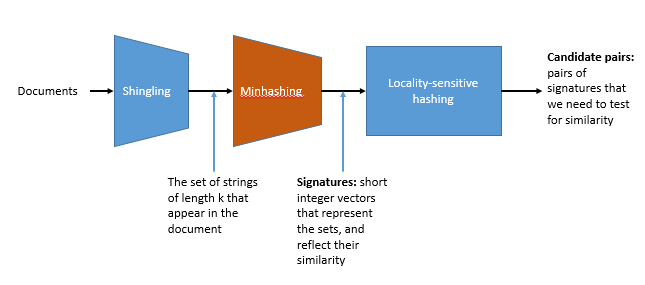
4. Shingles#
A k-shingle (or k-gram) for a document is a sequence of k characters that appears in the document.
Example: k = 2; doc = abcab. Set of 2-shingles: {ab, bc, ca}.
Represent a doc by its set of k-shingles.
Documents that are intuitively similar will have many shingles in common.
Changing a word only affects k-shingles within distance
kfrom the word.Reordering paragraphs only affects the
2kshingles that cross paragraph boundaries.Example: k=3,
The dog which chased the catversusThe dog that chased the cat.Only 3-shingles replaced are
g_w,_wh,whi,hic,ich,ch_, andh_c.
5. Minhashing: Jaccard Similarity#
The
Jaccard similiarityof two sets is the size of their intersection divided by the size of their union.
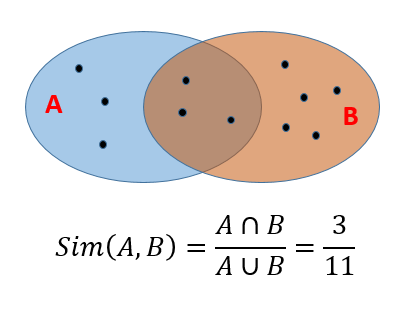
Convert from sets to boolean matrices.
Rows: elements of the universal set. In other words, all elements in the union.
Columns: individual sets.
A cell value of
1in row e and column S if and only if e is a member of S.A cell value of
0otherwise.Column similarity is the Jaccard similarity of the sets of their rows that have the value of
1.Typically sparse.
This gives you another way to calculate similarity: column similarity = Jaccard similarity.
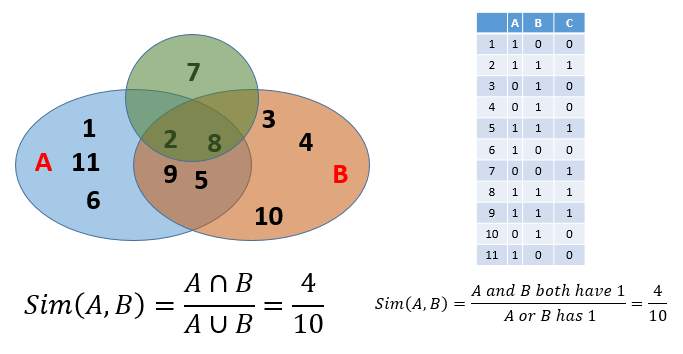
Generally speaking, given two columns, rows maybe classified as:
a: 1 1
b: 1 0
c: 0 1
d: 0 0
Sim(C1, C2) = a/(a+b+c)
6. Minhashing#
Imagine the rows permuted randomly.
Define
minhashfunction h(C) = the number of the first (in the permuted order) row in which column C has 1.Use several (e.g., 100) independent hash functions to create a signature for each column.
The signatures can be displayed in another matrix called the signature matrix
The signature matrix has
its columns represent the sets and
the rows represent the
minhashvalues, in order for that column.
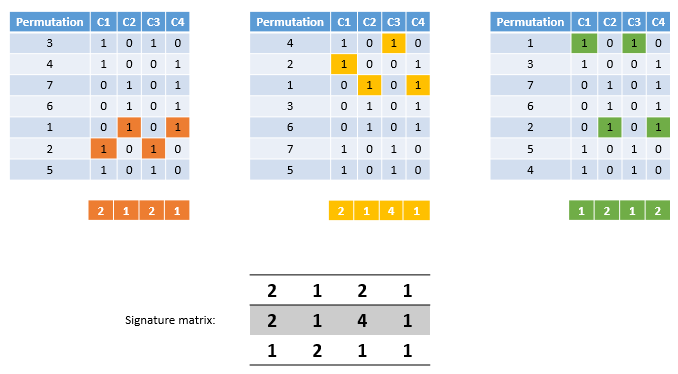
6. Minhashing: surprising property#
The probability (over all permutations of the rows) that h(C1) = h(C2) is the same as Sim(C1).
Both are a/(a+b+c)!
The similarity of signatures is the fraction of the minhash functions in which they agree.
The expected similarity of two signatures equals the Jaccard similarity of the columns.
The longer the signatures, the smaller the expected error will be.
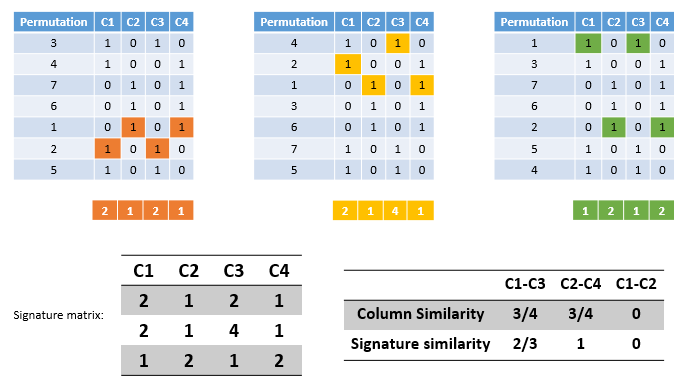
8. Hands-on Minhashing: implementation#
Can’t realistically permute billion of rows:
Too many permutation entries to store.
Random access on big data (big no no).
How to calculate hashes in sequential order?
Pick approximately 100 hash functions (100 permutations).
Go through the data set row by row.
For each row r, for each hash function i,
Maintain a variable M(i,c) which will maintain the smallest value value of hi(r) for which column c has 1 in row r.
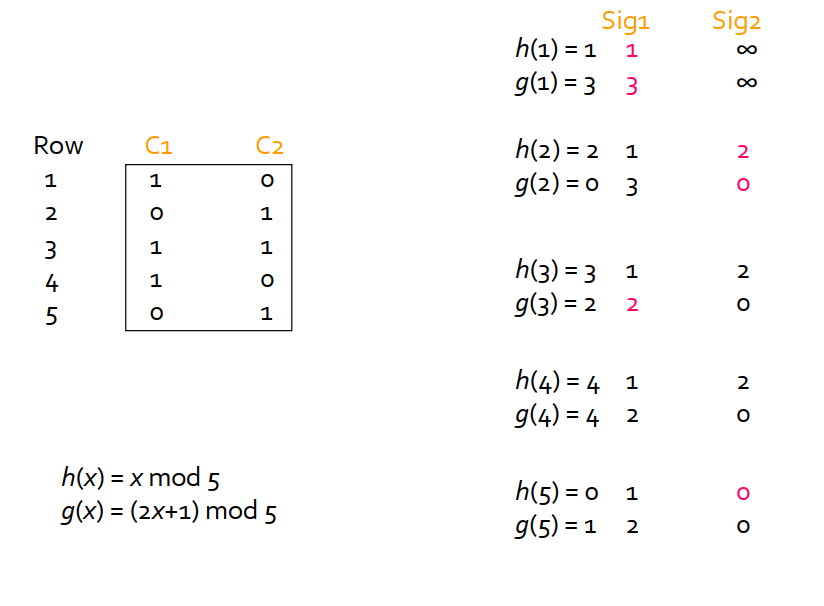
9. Minhashing:#
Create three additional row permutations, update the signature matrix, and recalculate the signature similarity.
Does the signature similarity become closer to the column similarity?
10. Locality-sensitive-hashing (LSH)#
Generate from the collection of signatures a list of candidate pairs: pairs of elements where similarity must be evaluated.
For signature matrices: hash columns to many buckets and make elements of the same bucket candidate pairs.
Pick a similarity threshold
t, a fraction < 1.We want a pair of columns
canddof the signature matrix M to be acandidate pairif and only if their signatures agree in at least fractiontof the rows.
11. LSH#
Big idea: hash columns of signature matrix M several times and arrange that only similar columns are likely to hash to the same bucket.
Reality: we don’t need to study the entire column.
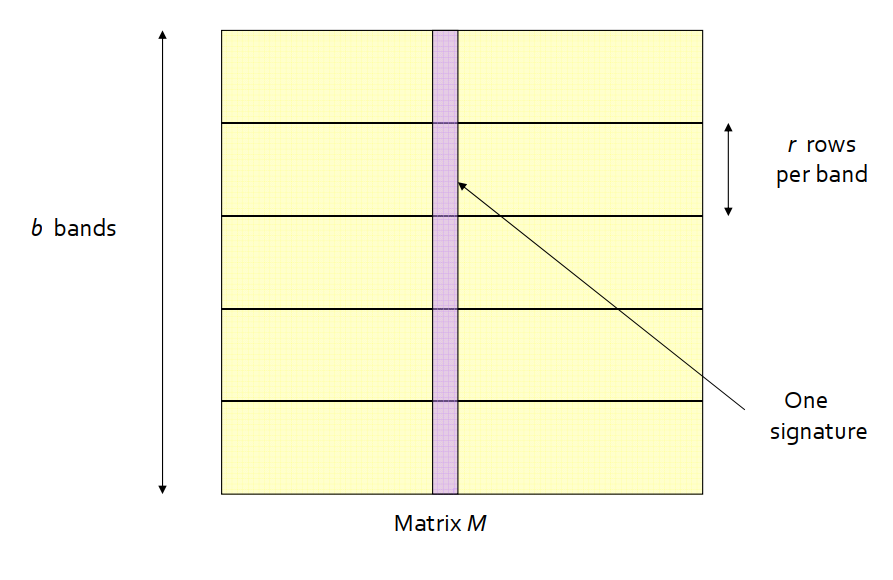
Divide matrix M into
bbands ofrrows each.For each band, hash its portion of each column to a hash table with
kbuckets, withkas large as possible.Candidatecolumn pairs are those that hash to the same bucket for at least one band.Fine tune
bandr.We will not go into the math here …
12. Hands on LSH#
Download the set of inaugural speeches from https://www.cs.wcupa.edu/lngo/data/inaugural_speeches.zip.
Launch a Spark notebook and create the two initial setup cells.
